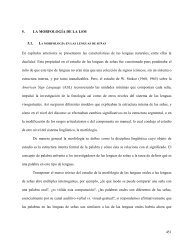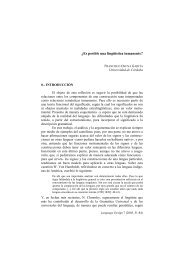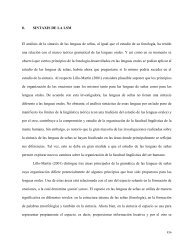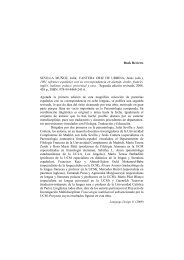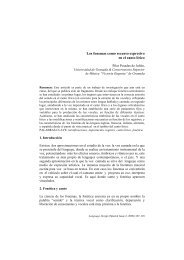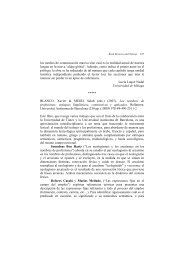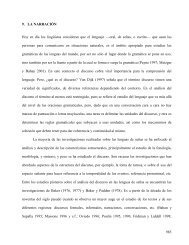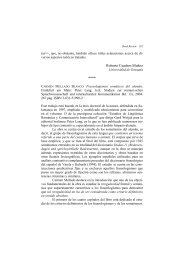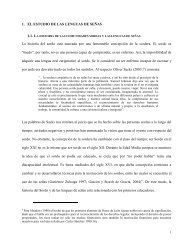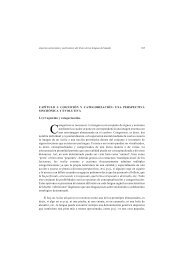Relaciones argumentativas en expresiones idiomáticas
Relaciones argumentativas en expresiones idiomáticas
Relaciones argumentativas en expresiones idiomáticas
- No tags were found...
You also want an ePaper? Increase the reach of your titles
YUMPU automatically turns print PDFs into web optimized ePapers that Google loves.
Susana Creus 40ANSCOMBRE, J-C. 1997 “Reflexiones críticas sobre la naturaleza y elfuncionami<strong>en</strong>to de las paremias”. Paremia, Madrid: Asociación CulturalIndep<strong>en</strong>di<strong>en</strong>te, n. 6, pp. 43-54.ANSCOMBRE, J-C. 1999 “Estructura métrica y función semántica de losrefranes”. Paremia, n. 8, pp. 25-36.ANSCOMBRE, J-C. 2000 “Parole et structures métriques”. Langages, 139, pp. 6-26.AYTO, J. 1990 Dictionary of Word Origins. The Histories of More than 8,000English Language Words. New York: Arcade Publishing.GONZÁLEZ REY, I. 2002 La phraséologie du français. Toulouse: PressesUniversitaires du Mirail.BRUXELLES, S., RACCAH. P-Y. 1987 “Information et argum<strong>en</strong>tationl’expression de la conséqu<strong>en</strong>ce”. Cognitiva, Paris, n. 87, v.1.BRUXELLES, S., DUCROT, O., RACCAH, P.Y. 1995 “Argum<strong>en</strong>tation and theLexical Topical Fields”. Journal of Pragmatics, 24/1-2, pp. 99-113.CACCIARI, C. 1993 “The Place of Idioms in a Literal and Metaphorical World”.In: Idioms. Processing, Structure, and Interpretation. Hillsdale: Lawr<strong>en</strong>ceErlbau Associates.CAREL, M. 1995 “Pourtant: Argum<strong>en</strong>tation by exception”. In: Journal ofPragmatics, 24/1-2, pp. 168-187.CAREL, M. 1992 Vers une formalisation de la Théorie de l’Argum<strong>en</strong>tation dansla Langue. Thèse de doctorat, EHESS. Paris.CAREL, M. 1997 “L’argum<strong>en</strong>tation dans le discours: argum<strong>en</strong>ter n’est pasjustifier”. Letras de Hoje, Porto Alegre: PUCRS, v. 32, n. 1, pp. 23-40.CAREL, M. 1998 “Argum<strong>en</strong>tación normativa y argum<strong>en</strong>tación exceptiva”. In :Signo & Seña. L<strong>en</strong>gua, argum<strong>en</strong>tación y polifonía. Bu<strong>en</strong>os Aires:Instituto de Lingüísitca. Universidad de Bu<strong>en</strong>os Aires, n. 9.CAREL, M. 1999 Le Problème du Paradoxe dans une SémantiqueArgum<strong>en</strong>tative. Langue Française, Paris: Larousse, n. 123, pp. 41-51.CAREL, M. 2000 “Para un tratami<strong>en</strong>to argum<strong>en</strong>tativo de la predicación”.Discurso y Sociedad. Barcelona: GEDISA, v. 2, n. 4, pp. 45-72.CAREL, M. 2001a Prés<strong>en</strong>tation générale de la théorie des blocs sémantiques.Conferência sobre polissemia e indeterminação semântica, Florianópolis.CAREL, M. 2001b “Qu’est-ce qu’argum<strong>en</strong>ter?”. Revista de Retórica y Teoría dela Comunicación, n.1, <strong>en</strong>ero, pp. 75-80. Versión electrónica:www.asociación-logo.org/revista-logo.htm.CAREL, M., SCHULZ, P. 2002 “De la généricité des proverbes”. Langage &Société, 102, pp. 33-70.CHAFE, W. 1968 “Idiomaticity as an Anomaly in the Chomskyan Paradigm”.Foundations of Language, Berkeley, CA, v.4, pp. 109-127.CHMELIK, E. 2001 Contribution à une sémantique générale des langues: unedescription des connecteurs hongrois “pedig” et “mégis” et du français“pourtant”. Tesis de Lic<strong>en</strong>ciatura. Université de Paris-III.



